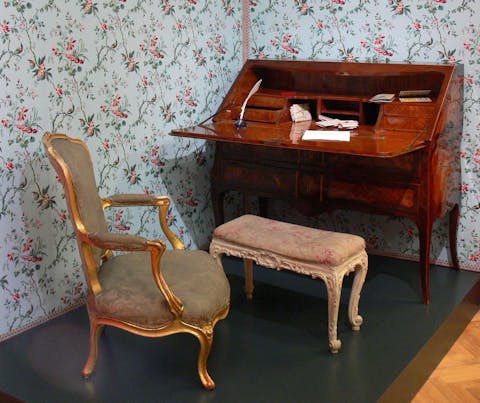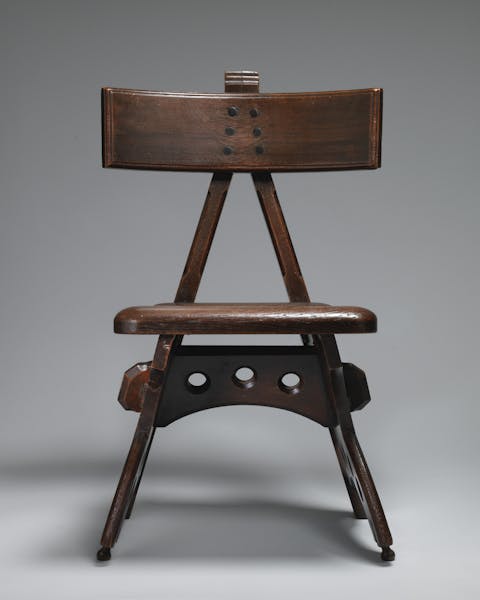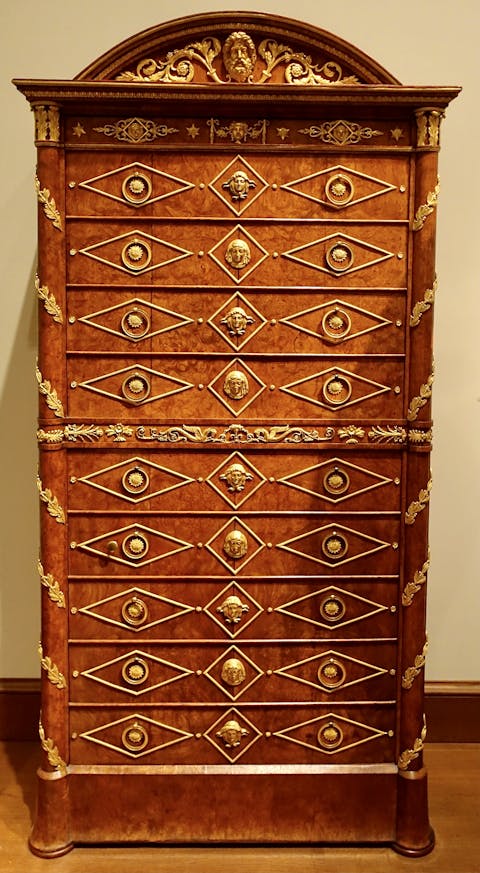How to Value Antique Furniture
Many might assume that antique furniture has a primarily aesthetic appeal, but the variety of pieces, their utility, and their history make furniture more than decorative. The market for antique furniture is enormous. This article guides you through antique furniture and how to value it. Value My Stuff has renowned experts who can value your antique furniture.
A view of room with antique furniture (Public Domain)
Antique Furniture
It is no secret that the current antique furniture market is not strong, but many observe that the best pieces continue to sell well. "Brown" furniture has not been popular amongst interior designers in recent years. Still, it does show some signs of life, and like past periods of disinterest (1950s style also strongly rejected Victorian furniture, for example), prices may well see a recovery in the future as more and more people reject the dominance of minimalism and mass-produced furniture.
Follow these easy steps to value your antique furniture.
Antique Furniture Styles
As much as architecture or any other antique, furniture has defined the periods of style widely recognised today. In many cases, furniture is synonymous with particular types, such as a Chippendale chair with the mid-Georgian style or a gilt Pineau console table with Louis XV Rococo. This is reflected in the many revival styles that have occurred. In his Gentlemen and Cabinet-Maker's Director, probably the first furniture catalogue, Chippendale's iconic Georgian style appears alongside the equally popular Neo-Gothic and Oriental styles, which sought to recreate fantasies of medieval Europe and far-away China and Japan. Similarly, the 19th century saw revivals of the more recent Rococo style, as well as "Antique" furniture, inspired by a contemporary fascination with Ancient Egypt following the Napoleonic campaigns there and with the excavations at Pompeii and Herculaneum. Furniture makers were very aware of the history of their designs and were often very faithful to original styles when making revival furniture.
As well as their own history, furniture markers have also always worked within a distinctly local tradition, particularly in provincial furniture making. Country ("vernacular") furniture, such as a Windsor chair, often changed little in design over the generations and retained its local style in the face of changing fashion. In some pieces, such as dressers, the origins, and even makers can be identified by stylistic traits alone. What might be called a "Welsh" dresser might be a typical Montgomery piece or identifiable to Caernarfon.
Furniture For Every Occasion
Most people take their chairs, tables, and other furniture for granted as catering to needs that we've always had: to eat, to rest, and to store our possessions. This ignores the enormous functional transformations our household furniture has undergone over the last 500 years, as the humble oak stool and chest have given way to the modern sofa via the chaise-longue and the wardrobe via the linen press. In the dining room, for example, changing dining habits replaced great long, rectangular tables often taking up most of a hall or living space with tables that can be stowed away after use and smaller tables for more intimate dining. Breakfast tables first introduced the idea of different furniture for different meals before the introduction of tea in the 17th century, creating the fashion for tea tables and even "teapoys" to store the tea.
Even more marked is how living spaces have changed. The introduction of upholstered "easy" chairs in the late 17th century led to a quest for comfort, culminating in the wing armchairs of the 18th century and the heavily upholstered Victorian furniture of the 19th. The 19th century also heralded the widespread change in room arrangement that took furniture away from the walls and into the centre of rooms; this allowed for the birth of centrepieces as well as sofas and sofa tables as we know them today. By this time, drawing rooms also featured game tables, drum tables, nests of tables, occasional tables, and side tables.

A set of antique furniture, Reiss-Engelhorn-Museen, Mannheim. (Public Domain)
Furniture Construction
Changes in the use of furniture have driven great innovation in furniture making. Where medieval furniture is often too cumbersome and uncomfortable to be used faithfully in a modern setting, the introduction of upholstery and mechanisms for saving space and adding utility to pieces has made the way we use contemporary furniture change entirely. Innovations such as the drawer, which spread in Europe from medieval Spain (itself also influenced by Moor culture) and mechanisms for changing the size of tables (including gateleg, drop-leaf, "Jupe's patent", and telescopic tables, to name a few) have revolutionised furniture design. The bureau is an example of a piece designed for writing and storage in one unit. Still, it was just one part of an evolutionary chain from the Spanish vargueño (writing desk) to the bureau bookcase or the bureau à cylindre, furniture adapting to the needs of its market at every stage. To facilitate this kind of change, new methods of joinery, materials, and decoration methods were constantly discovered and rediscovered, making it easy to see why furniture continues to fascinate collectors today.
What Do Experts Look For in Antique Furniture?
Usually, the furniture experts first assess the style and the materials used to date the piece. They look for damage and defects. There are certain kinds of wear and tear that constantly appear in genuine antique furniture. For example, antique chairs often have recurring damage to their front legs caused by spurs, indicating the chair's age. The joinery, types of wood, and markings also reveal a lot of information while estimating the age of the piece. Everything out of the ordinary, such as materials, types of wood, or decorations that do not correspond with the historical period, can indicate forgery or remodelling of the piece, so-called marriage. That is why the expert can often ask you for extra images of the inside of a drawer, a close-up image of a handle, or a joinery. The same applies to dating vintage furniture, as the specialist will know precisely how designers constructed their pieces and with what materials. To help assess the age of other items like a mirror or a cabinet, an image of the back can be helpful. However, as with all furniture, please only attempt to move the piece if it is safe and easy to do so.
Where to Buy Antique Furniture
We recommend always buying from a well-versed dealer. There are many beautiful and high-quality antique furniture that can be found at your local antique shop or antique fairs. Online platforms are also an option, but since furniture tends to be heavy and large in size, the shipping cost could be very high if you don't buy locally. If you are unsure of the value of antique furniture you are interested in purchasing or want to make sure it looks legitimate, our experts are here to help. Press here for more information.
Valuing Antique Chairs
Most antique furniture will have many recent precedents in salerooms simply because there is so much of it! Once a piece is accurately dated and its condition assessed, it can be easily compared to other examples. Typically, the age of a chair is given away by the shape of the piece and the choice of decoration. Certain parts of the chair, such as the legs or top rail, give away the date of many chairs, sometimes with surprising accuracy. Matters are complicated somewhat by the popularity of revival styles in the 19th century, many of which were very faithful to the originals; a familiarity with original pieces and knowledge of the manufacturing techniques will be needed in these cases.
Dining chairs and side chairs were usually made in sets of any even number up to 36, although most of these will have been broken up into smaller groups. Larger groups of at least 8 attract greater interest, and in odd-numbered sets, the "odd" chair usually won't add to the value. Chairs do not need to be identical to comprise a set, and some vernacular chairs may have stylistic variations within a set. Many sets included chairs with and without arms; elbow chairs usually add to the value of a dining set. Unfortunately, this has led to many sets being bulked out with married pieces featuring components and other parts from similar sets. All chairs within a set should be examined individually for inconsistencies.

Side chair, 1870, Edward Welby Pugin (British)
Valuing Antique Tables
In many cases, there is less variation amongst dining tables than other furniture, with fewer stylistic features to identify them. Perhaps the hardest to date are the simplest; a gateleg mahogany table with few embellishments could be dated to the 18th, 19th, or 20th centuries by an untrained eye. Certain types of tables can be given an approximate date by their kind. For example, the first extending dining table was made c.1730, and "Jupe's patent" circular extending tables were found from 1835 onward. The more decorative console tables, pier tables, serving tables, and sideboards are often more easily dated by decoration. As more decorative pieces, these types of tables can attract high prices, particularly when featuring original marble or as part of a set, but have also been faked, so good examples sell best with provenance.
Valuing Antique Storage Furniture
Storage furniture such as wardrobes, armoires, linen presses, chests, and chests-of-drawers have changed relatively little in function since the 18th century. At that time, graduate drawers had become common use, and pieces such as high chests-of-drawers, chests-on-chests, and dressers had reached their definitive forms. As large pieces, storage furniture often appears architectural in style, so features such as pediments can be used significantly to date according to style. This method falls, however, when looking at vernacular pieces such as dressers, which have a more regionalised style. As some of the oldest common pieces on the market, chests, and coffers are usually altered or repaired in one way or another, often married and sometimes faked. Matched or faked pieces will sometimes be distressed artificially to give the appearance of wear consistent with their age but are usually given away by mismatching carving, wood grain, or colouration.

Secretary, France 1804-1814, amboyna wood veneered on pine, gilt-bronze mounts, Metropolitan Museum of Art, New York. (Public Domain)
How To Get Antique Furniture Valued
Only a professional can provide you with a sure and particular range of value and an up-to-date price for your antique furniture by using their experience and expertise to eliminate as much chance for misstep and error as possible. Luckily, here at Value My Stuff, experts in the field can provide professional valuation services so that you can take the necessary steps to discover how much your antique furniture is worth today! Start Your Antique Furniture Valuation Here!
How Much is My Antique Furniture Worth?
Several factors are taken into account while establishing the value of your antique or vintage pieces. One of the most important is the age of the piece and its authenticity. There are not so many authentic pieces of furniture that survived to our times in their original untouched form. Chairs and sofas were reupholstered with new fabrics if the old, the front legs of chairs and sofas were often replaced when the old ones gave up, and the chests and wardrobes were remodelled or uplifted with new decorations. The fewer changes and repairs applied to the furniture, the more value it will hold.
Another vital factor is the state of the furniture market at the moment. As with anything, some things are more trendy and in fashion than others, and while heavy dark wood Victorian pieces may be harder to sell this year, they may be more valuable a year after.

Family dining room vitrine, designed by Eugene Gaillard, maker unknown, Paris, 1899-1900, Bröhan Museum, Berlin. (Public Domain)
The Condition of Antique Furniture
An essential component of the value of your furniture is the condition of the piece. If your gorgeous Victorian canopy bed was once infested by woodworm that weakened its construction, your Louis VXI writing desk was affected by moisture that led to mould and fungi. If the chrome construction of your Le Corbusier sofa is rusty, then the value of those pieces will be significantly affected. It is always good to seek help from a professional furniture conservator to fix those things before seeking valuation or selling your pieces.
The Provenance of Antique Furniture
The last aspect of the valuation is its provenance. The worth of your armchair or chest of drawers will increase if you prove a famous furniture maker or designer made it. Antique furniture made by André-Charles Boulle, George Hepplewhite, Josef Dannhauser, or vintage furniture designers such as Charles and Ray Eames, Paul Evans, or Gino Ponti will be worth much more than from an unknown. If you are lucky enough to inherit a piece of furniture that belonged to your Rock-Star icon uncle, this may also significantly boost its value.
Our Antique Furniture Experts
After studies in architecture, our English and Continental furniture expert embarked on a career in fine art auctioneering. He became a Fellow of the Royal Institution of Chartered Surveyors. Until February 2012, he was the senior English and Continental furniture valuer at Sotheby's in Bond Street for the past thirty-two years. This entailed valuations of many of the significant collections in palaces, castles, and country houses throughout the U.K. and overseas and involvement with important dispersals such as Thurn und Taxis, Baden, and Chatsworth House.
Our continental furniture specialist joined Sotheby's as a porter after university in 1994 and spent the whole of 1995 working on the Baden-Baden house sale. He then became a furniture specialist and, in 2000, worked in Germany to help put together a major house sale at Schloss Mon Repos. He is a member of the Royal Institute of Chartered Surveyors (MRICS) and has been evaluating and cataloguing antique furniture for 20 years.

